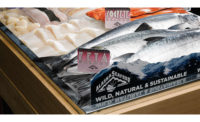STATE OF THE INDUSTRY: SEAFOOD
State of the Industry: Steady seafood consumption poised for growth
Messaging focusing on seafood’s nutrition, sustainability and cooking tips resonates with consumers.

Photo credit: ASMI
Despite inflationary pressures in the first half of the year, global consumption of seafood is on track for 2024 to surpass pre-pandemic levels, providing a reassuring outlook for the industry at large. The fish and seafood market is projected to show a 2.3% volume growth in 2025, with annual revenue growth of 3.88% through 2029.1 Those projections are supported by current consumer attitudes: According to research from Circana on behalf of Alaska Seafood Marketing Institute (ASMI), 61% of consumers eat seafood at least once per week, and more than half are eating seafood more than they were two years ago.2
In order to make the most of this recovery, here’s what processors, retailers and foodservice operators should focus on in the year ahead.
- Highlight nutrition benefits: Seafood is full of high-quality protein, vitamins, minerals and naturally occurring omega-3 fatty acids EPA and DHA that are vital to heart and brain health, all factors that continue to drive consumers to the category. In fact, 68% of consumers believe seafood’s nutrition benefits set it apart from others in the protein category3 and 78% of frequent seafood consumers say they prioritize health and nutrition.4 Marketing efforts should continue to communicate the health benefits of seafood, which consistently win out against other proteins.
- Provide cooking inspiration: Home-cooked seafood constitutes 59% of seafood consumption, up from 53% last year, with restaurant consumption decreasing an equal amount.4 While sales and promotions are the primary in-store purchase driver, 2 in 3 shoppers say cooking guidance, like recipes, techniques and more, would inspire them to consume seafood more often.5 For both cost and convenience, shoppers are attracted to value-added products like marinated filets or fresh-prepared items like kebabs and salmon cakes. For example, an Alaska seafood wholesaler recently launched frozen miso-glazed Alaska black cod filets to great success, introducing what was traditionally perceived as a high-end, luxury species to aspiring home cooks around the country. Cooking inspiration tied to key seasonal moments like simple meals for Back to School time periods or how to weave seafood into upcoming holidays is also beneficial.
- Emphasize source and sustainability: Seafood consumers prefer wild-caught seafood 4:1 over farmed, and across the U.S., shoppers prefer seafood from Alaska 5:1 compared to other sources.2 For processors, retailers, and foodservice operators, this means continuing to highlight the source, such as Alaska, as well as sustainability certifications, such as Responsible Fisheries Management (RFM). Ensuring that sustainability is communicated to the end-buyer via the seafood counter staff, labeling or menuing will also help to increase sales; 82% of consumers are more likely to buy seafood when they see the Alaska Seafood logo, as they associate it with fresh, great-tasting, and high-quality seafood.2
- Provide Variety: Seafood in more formats means more sales overall – seafood sales at retail increased over the past 4 years in every segment including refrigerated, frozen and shelf-stable. 79% of seafood consumers are likely to buy frozen seafood, which is seen as affordable, convenient and increasingly recognized as equal in quality to fresh. Plus, having it available and promoted year-round in more places in the store will ensure that consumers are able to easily find and purchase it.
- Take Risks in Foodservice: For the 88.1% of restaurants that menu seafood, operators shouldn’t be afraid to branch out, with consumers often looking to try out new seafood species in foodservice environments. One major quick-serve chain saw massive success menuing Alaska flounder for their fish sandwich in 2024, in place of the more often used pollock or cod. We also continue to see more restaurants and chefs showcasing sablefish in a variety of ways due to its rich, buttery flavor profile. As consumers eat more seafood overall, restaurants can serve as an entry point to new varieties.
The seafood industry faced a challenging year in 2024, riding the waves of supply, demand and inflationary pressures. But overall seafood consumption remained steady, and poised for growth as inflation eases; in fact, 74% of consumers wish they ate seafood more than they do. Industry members can help them do so in 2025 by focusing on nutrition, sustainability, cooking tips, and offering new varieties.
1 Statista
2 Circana for ASMI, December 2023
4 FMI 2024 Power of Seafood Report
5 Material+ for ASMI, 2023
Looking for a reprint of this article?
From high-res PDFs to custom plaques, order your copy today!








